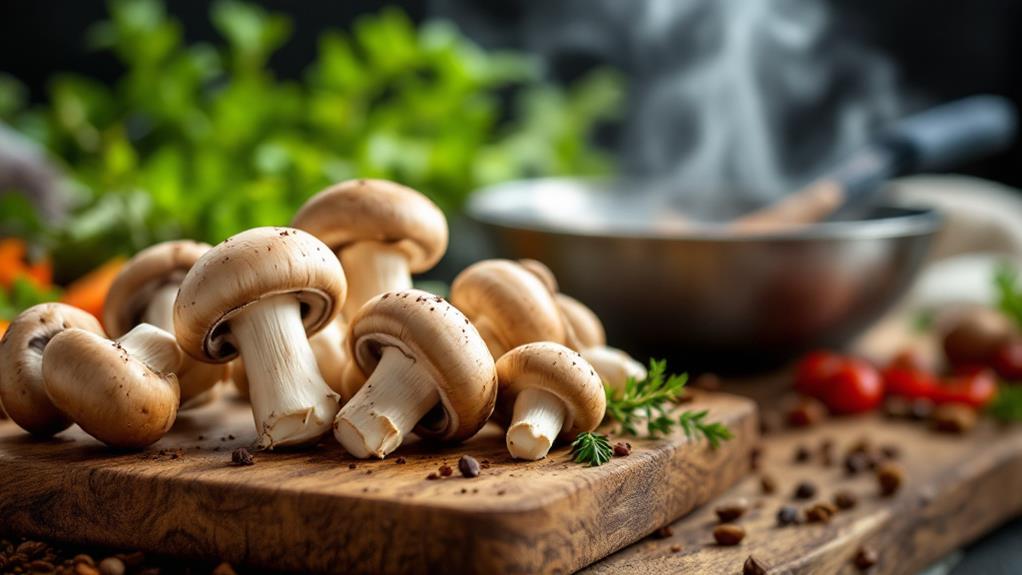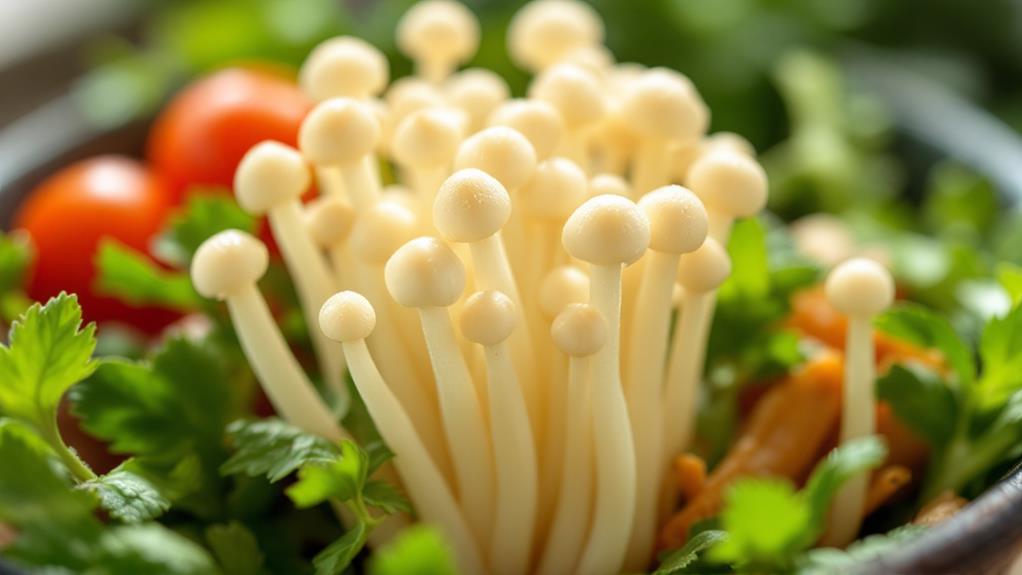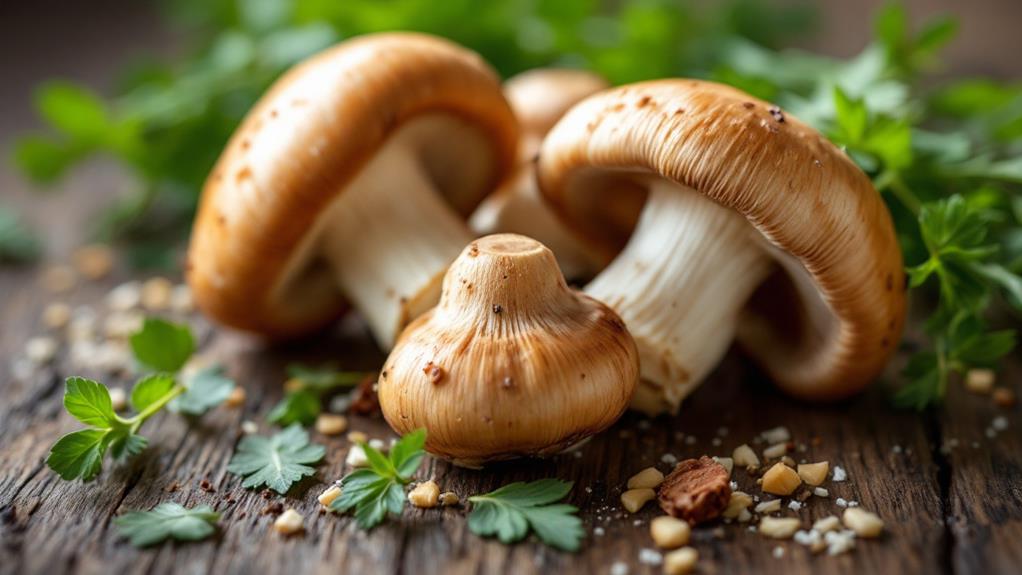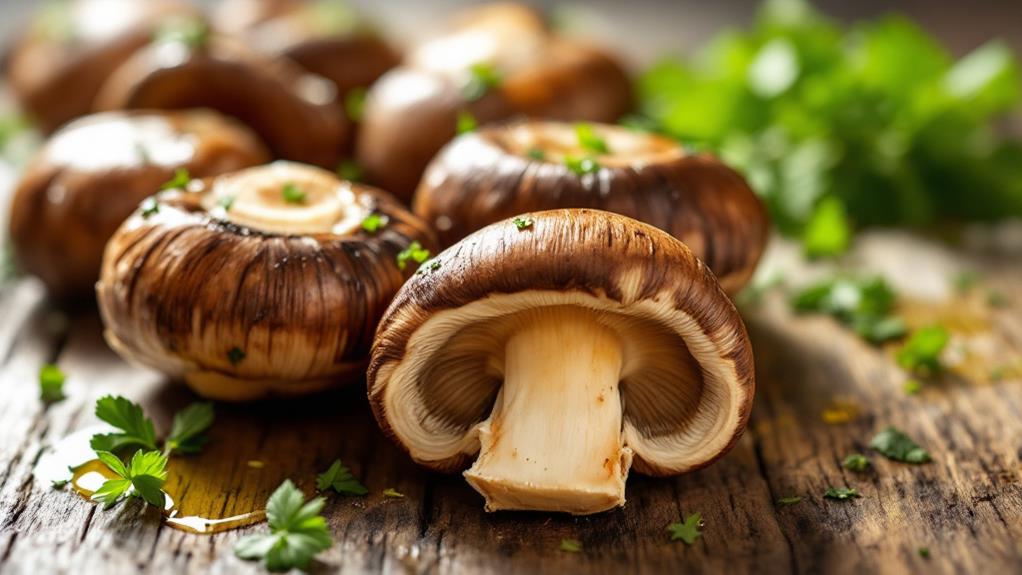The Ultimate Guide to Mushrooms: Types, Health Benefits, and Cooking Tips
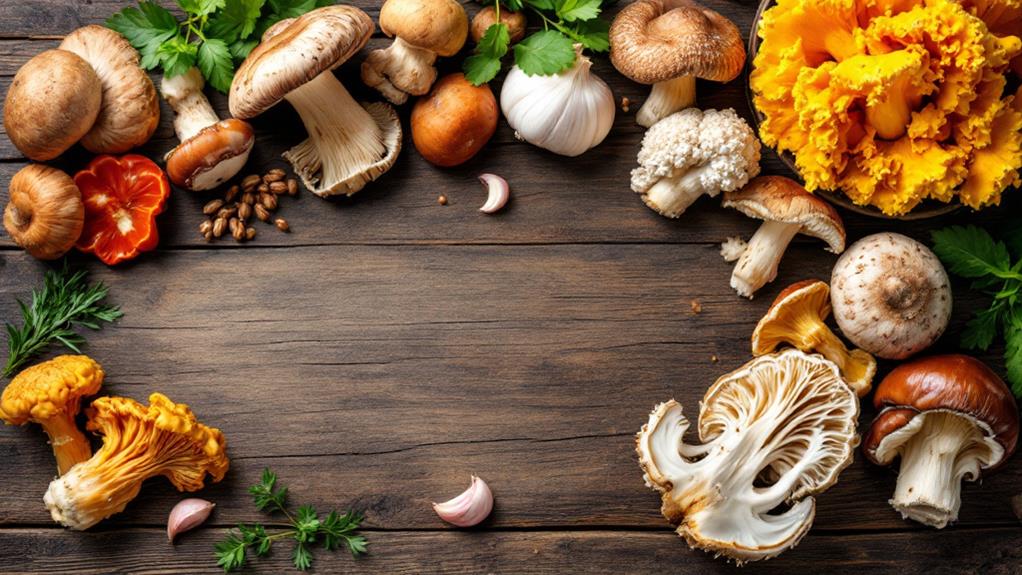
In your expedition to mastering mushrooms, start by choosing ones with firm textures and avoid dark, damp spots. Store them in a paper bag in the fridge to keep them fresh. Trim the stems and use a damp cloth for cleaning, ensuring they aren't soaking. Investigate varieties like button for mildness or shiitake for a smokier taste. Cooking techniques range from sautéing chanterelles to frying morels in butter. Health-wise, mushrooms pack in vitamins D and B, antioxidants, and unique benefits like stress reduction. Proper foraging is crucial, so only pick what you can confidently identify. There's more fascinating fungus knowledge awaiting.
Selecting and Storing Mushrooms
When you're selecting mushrooms, always aim for those with firm textures and consistent colors. Avoid mushrooms with dark spots or damp appearances, as these are signs they're not fresh. Firm texture indicates that the mushroom is in good condition, ready to deliver its best flavor and nutritional benefits. Once you've chosen the perfect mushrooms, it's essential to store them properly to maintain their quality.
To store mushrooms, keep them in your refrigerator inside a brown paper bag. This method allows the bag to absorb excess moisture, preventing spoilage that often occurs when mushrooms are stored in plastic bags. Plastic traps moisture, which can lead to slimy mushrooms and a shorter shelf life. Remember, it's best to purchase mushrooms a few days before you plan to use them to guarantee peak freshness.
Keep mushrooms away from ethylene-producing fruits like apples, as these can accelerate spoilage. For peak freshness, consume mushrooms within a few days of purchase. Proper storage helps maintain their flavor and texture, assuring your dishes are as delicious as possible. With these tips, you can enjoy your mushrooms at their very best.
Cleaning and Preparing Mushrooms
You've selected and stored your mushrooms properly, guaranteeing their freshness and flavor are intact. Now, it's time to focus on cleaning mushrooms to preserve their delightful texture when cooked. Start by trimming the woody stem ends, which helps improve their texture. For dirt removal, use a dry brush or a damp cloth to gently wipe away any soil without adding unwanted moisture. This method aids in moisture maintenance, preventing discoloration and sogginess.
If your mushrooms appear particularly dirty, a quick rinse under cold water is sufficient. Avoid prolonged soaking, as it can lead to increased water absorption, resulting in a less appealing, soggy texture. Always use your judgment based on the dirtiness of the mushrooms—if they look clean, you might skip washing altogether to guarantee flavor preservation.
To store mushrooms correctly and maintain mushroom freshness, place them in a brown paper bag in the refrigerator. This technique allows them to breathe and absorbs excess moisture, unlike plastic bags, which trap humidity and can ruin their texture. By following these steps, you'll enjoy perfectly fresh, flavorful mushrooms in your culinary creations.
Edible Mushroom Varieties
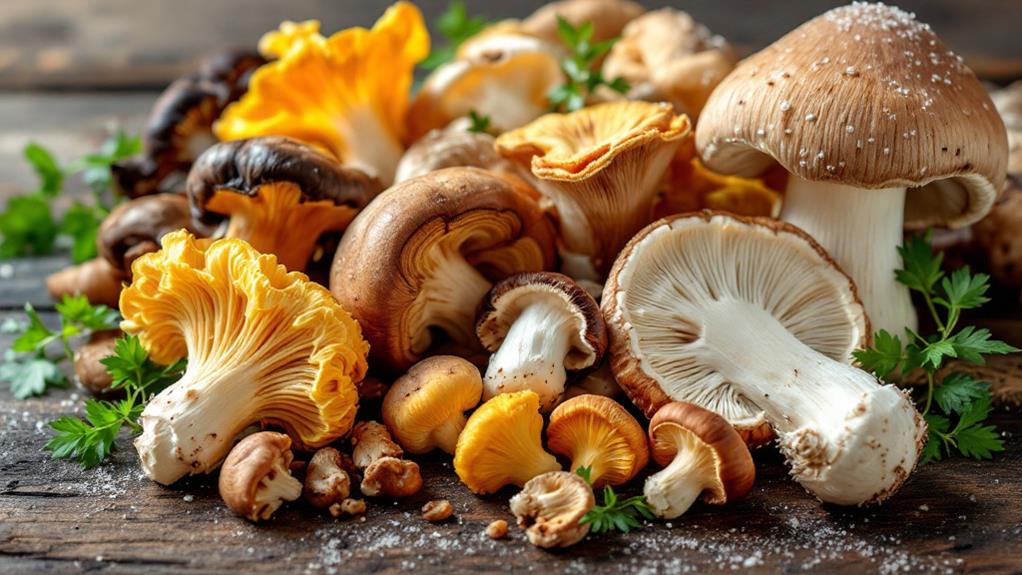
Mushrooms' delightful variety offers a range of flavors and textures to improve your culinary creations. Among the most popular edible mushrooms, Button Mushrooms stand out with their firm texture and mild flavor. They're incredibly adaptable, fitting seamlessly into salads, pastas, and even pizzas. If you're looking for a bit more depth, Crimini Mushrooms, which are fundamentally mature button mushrooms, provide a richer flavor. They're perfect for sautéing, grilling, or adding a robust touch to sauces and soups.
For a heartier option, consider Portobello Mushrooms. These mature Crimini Mushrooms boast a meaty texture and rich flavor, making them a fantastic meat substitute in vegetarian dishes. Their ability to absorb marinades boosts their versatility in different recipes. On the other hand, Oyster Mushrooms offer a delicate, mild flavor and are commonly used in Asian cuisines. Their adaptable nature makes them great for stir-frying, sautéing, or adding to soups.
Shiitake Mushrooms, with their rich, smoky flavor, are another favorite in Asian cooking. Besides their culinary appeal, they also offer potential health benefits, including immune support. These mushrooms' varied characteristics guarantee you can exploit their full potential with the right cooking tips.
Cooking Techniques and Tips
Cooking mushrooms can transform their flavors and textures, making your dishes truly shine. Let's start with chanterelles, which are best as the star ingredient in your recipes. Their nutty taste can improve soups and pasta, bringing a delightful depth to your dishes. When sautéed in butter, maitake mushrooms, also known as Hen of the Woods, add a rich flavor that pairs perfectly with roast chicken or complements broths and noodle dishes.
For a touch of luxury, grate fresh truffles over simple dishes like pasta or risotto. This technique adds an intense richness, raising the complete flavor experience. Morel mushrooms, with their unique texture, should be fried in butter. This method raises their rich flavor, making them a standout element in diverse recipes.
Lobster mushrooms are another adaptable choice, especially for seafood enthusiasts. Their seafood-like flavor is best highlighted when pan-fried, allowing them to complement an array of seafood dishes. If you're making a seafood stew or a creamy risotto, lobster mushrooms can improve the dish's complete flavor profile.
Experimenting with these cooking techniques can transform your mushrooms into culinary masterpieces, improving your favorite recipes.
Health Benefits of Mushrooms
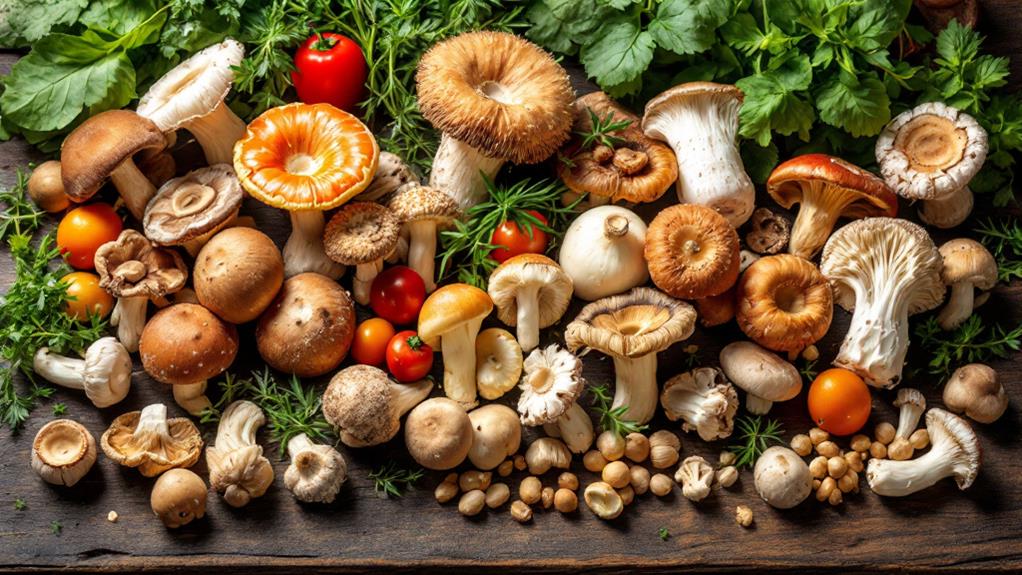
While mastering the art of cooking mushrooms can improve your culinary creations, understanding their health benefits adds another layer of appreciation to these versatile fungi. Mushrooms are rich in crucial nutrients like vitamins D and B, selenium, and antioxidants, providing natural support for your immune system and general well-being. Medicinal mushrooms like Reishi, Lion's Mane, and Turkey Tail offer specific health advantages worth exploring.
Reishi, often called the "mushroom of immortality," is celebrated for its stress management benefits. As an adaptogen, it helps manage anxiety and promotes cardiovascular health. Lion's Mane is known for enhancing cognitive function by supporting nerve growth factor production, potentially improving memory and focus. Turkey Tail mushrooms are loaded with polysaccharides and beta-glucans, which play a significant role in immune support, especially beneficial for those undergoing cancer treatment.
Chaga mushrooms, another powerhouse, are packed with antioxidants that reduce inflammation and oxidative stress, further strengthening immune health. If you're looking to incorporate these health benefits into your regimen, consider mushroom supplements as an accessible option.
- Immune support: Rich in polysaccharides and antioxidants.
- Cognitive function: Improved by Lion's Mane.
- Stress management: Supported by Reishi's adaptogenic properties.
Safety and Foraging Tips
In relation to mushroom foraging, guaranteeing your safety is fundamental, and proper identification is the initial critical step. Many edible varieties have toxic look-alikes, such as the deadly death cap and destroying angel. To avoid these, always guarantee accurate identification before harvesting wild mushrooms. Reliable field guides or mobile apps can be useful tools, but joining local mycology clubs or workshops offers expert guidance that can greatly improve your skills.
It's imperative to familiarize yourself with local regulations, as some areas may have restrictions or require permits for mushroom foraging. These rules help protect both you and the environment, guaranteeing sustainable practices. Moreover, be mindful of where you forage. Avoid picking mushrooms near roadsides or potentially contaminated areas, as pollutants and pesticides can accumulate in fungi, posing health risks.
If you're ever faced with edibility uncertainty, it's best to err on the side of caution. Consuming even a small amount of a toxic mushroom can lead to severe reactions, so when in doubt, don't eat it. By following these safety tips, you'll have a more enjoyable and safe foraging experience.

